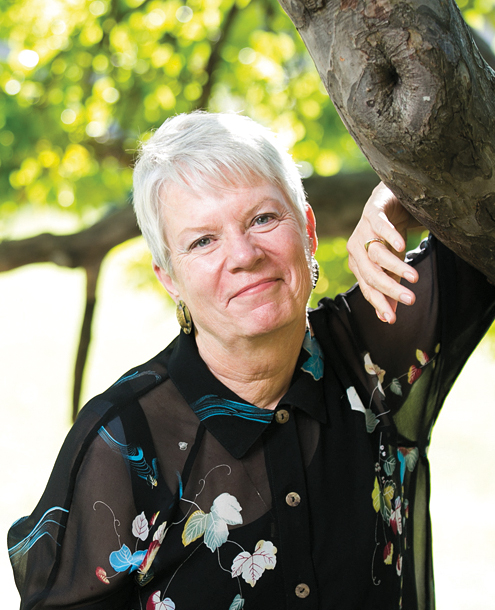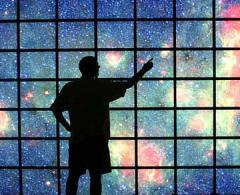
This Article From Issue
September-October 2018
Volume 106, Number 5
Page 310
Astronomer Jill Tarter is a pioneer in the Search for Extraterrestrial Intelligence (SETI), as well as the cofounder and retired director of the SETI Institute. During her long career she has pushed technological innovations to expand the hunt for signals from an alien civilization—an effort that continues more vigorously than ever with the aid of modern computers and signal processing. Tarter also achieved fictional fame as the inspiration for Ellie Arroway, the protagonist in the 1985 novel and 1997 movie Contact. Special issue editor Corey S. Powell talked with Tarter about the storied history of SETI.

Photograph courtesy of Jill Tarter
How did SETI begin and how did you end up leading it?
At the end of my graduate career [at the University of California, Berkeley], Stu Bowyer, who is an x-ray astronomer at Berkeley, had a clever idea about searching for intelligent life. Stu realized that with a radio telescope we could build some back-end equipment to analyze incoming radio waves to look for signs of an artificial signal. We could do this while the radio astronomers were using the telescope to do their investigations.
Stu showed up at my office door with a copy of the Cyclops report, an engineering study done in 1971 at NASA Ames Research Center and Stanford University, run by John Billingham at Ames and Barney Oliver from HP Labs. Their team of engineers came up with this idea to detect extraterrestrial intelligence: You build 1,000 100-meter telescopes in an array to find a signal. Stu said, “I want to do this. I want you to join my team. We only have one 85-foot telescope, but we can do some SETI.”
Did the idea of searching for extraterrestrial life seem crazy to you?
The NASA report had credibility associated with it. I was intrigued by the idea of doing more than one thing with a telescope at once. I went home and read the report cover to cover. I couldn’t imagine anything more fulfilling than using new telescopes and computers to try to answer questions that we had been asking for millennia [about other intelligent life in the universe]. So in my youth and naiveté, I just jumped in.
Your graduate thesis was on brown dwarf stars. Do you think your research on that topic prepared you for your career in SETI?
Years after I began working on SETI, I went back to visit my old department, and somebody asked about how I could get into this weird field. There was a venerable department secretary who had typed my thesis for me, and she explained it very simply. She said, “Jill used to look for things that are hard to find. Now you’re just looking for things that are damned impossible to find.” Brown dwarfs to SETI made all kinds of sense to her.
Because we don’t even know whether aliens exist, how did you decide what to look for in a SETI signal?
When we started out, we read Oliver’s arguments that narrow-band signals were not produced in nature. So when I volunteered for Billingham’s group, I said, “What’s the narrowest signal that nature can produce?” Then we started using spectrometers and various radio telescopes [to look for even narrower signals]. We built spectrometers and put them into a custom-made tractor-trailer. It just fit into a C-141, a military cargo plane. That’s how we were going to take our spectrometers around the world to various observatories.
We kicked off at Arecibo in Puerto Rico in 1992. It took us a long time to get the equipment working, shipped off, and hooked up to the telescope. Then we got another spectrometer built at the NASA Jet Propulsion Laboratory [JPL] and hooked up to the Deep Space Network [DSN, used to track spacecraft].
When the SETI program started, it included the search for both extrasolar planets and extraterrestrial intelligence. Why is the search for exoplanets no longer part of SETI?
In the early 1980s, it was clear that we were going to have a very rocky path. Lots of tar and feathers were probably in our future. John Billingham did a very wise thing asked David Black of the space sciences division at NASA Ames to take the extrasolar planets piece of the search and promote it in the space sciences, rather than in the life sciences, where we were situated. We separated the extrasolar planetary search from SETI so that it wouldn’t end up having the same difficult fate that SETI itself was facing. It was very clear that when you talked about intelligent life out there, it just rang all kinds of psychological bells with Congressmen.
Congress terminated SETI in 1993, a year after you had built your first spectrometers at Arecibo. How did you keep the program going?
We started raising private funds with the help of Oliver, who knew people in Silicon Valley who owed him favors. I called all the observatory directors about the time we had allocated for the NASA program and said, “If I can find the money to keep this going, can we still have the time?” They fortunately agreed.
Did your approach to SETI research change once you were independent?
In 1998 we were partway into this project we called Phoenix, rising from the ashes of Congressional termination. We held workshops to discuss what we should do for the next 20 years, later published in a report called SETI 2020. We came up with three ideas: We ought to build our own dedicated telescope, made up of a large number of small telescopes with extremely wide-band feeds and the ability to do multiple projects at the same time. We should begin to do optical SETI [looking for visible signals]. And we must have sensitivity to transients. Back then, a signal had to hang around for a half-hour to an hour for us to confirm it. We said, “We need to figure out how to look at all the sky, all the time, in all frequencies.” Twenty years later, we’re working on all three areas in different ways.
How did you balance the need for a broad search with the need for an in-depth look?
The NASA program [before 1993] had two prongs. One was the targeted search using the world’s large radio telescopes; the other was a sky survey, using the DSN 34-meter dishes around the world. When Congressional termination happened, we were able to transfer equipment for the targeted search to the SETI Institute or to other observatories. But without the DSN telescopes, we couldn’t keep the sky survey alive.
I’m happy that the sky survey is finally back for JPL. They moved a decommissioned 34-meter antenna outside the fence at Goldstone and built the Goldstone Apple Valley Radio Telescope [that now supports SETI research].
Did you ever find a signal that made you think, “This could be it”?
There was an interesting one in 1997. Our second radio-telescope antenna, which was built out of old AT&T ground stations that had been given to Georgia Tech, took a lightning hit that fried the computer’s disk drive. We continued to use the telescope that we were paying for in Green Bank, West Virginia, even though we knew using one telescope [without another for confirmation] was problematic.
Murphy’s Law hit with a vengeance, and one morning I found a signal that was clearly artificial. We all went off to an early dinner and did a bit of web searching. Finally we realized it was the SOHO spacecraft [a joint ESA-NASA mission to study the Sun], which was exactly 90 degrees away from the direction in the sky where we were pointing, landing in the side lobe of the antenna.
What is SETI doing now to extend the 2020 vision you outlined?
With artificial intelligence and neural networks, the machine simply could tell us if there’s anything that isn’t Gaussian [random] noise—and not be prescriptive about the type of signal we’re looking for. We’ve been held back from doing that by not having enough computational capability. But now, if the machines can learn what different types of signals are in our data, we can progress. (See “AI and the Detection of Extraterrestrial Life” by Graham Mackintosh.)
What if aliens don’t use radio or light?
A signal could well be gravitational waves, cosmic rays, or something we haven’t discovered. We’ve made a choice that we’re looking for photons. Having made the choice that we are searching for electromagnetic radiation, we've still got three dimensions of space, one dimension of time, two senses of polarity, and sensitivity. We don’t know how strong the signal is or how far away it is. We’ve been making deliberate searches for time compression and frequency compression, but there is also a modulation space that we haven’t explored. We’re beating down to those dimensions. We’re trying to get as systematic as we can in exploration.

American Scientist Comments and Discussion
To discuss our articles or comment on them, please share them and tag American Scientist on social media platforms. Here are links to our profiles on Twitter, Facebook, and LinkedIn.
If we re-share your post, we will moderate comments/discussion following our comments policy.